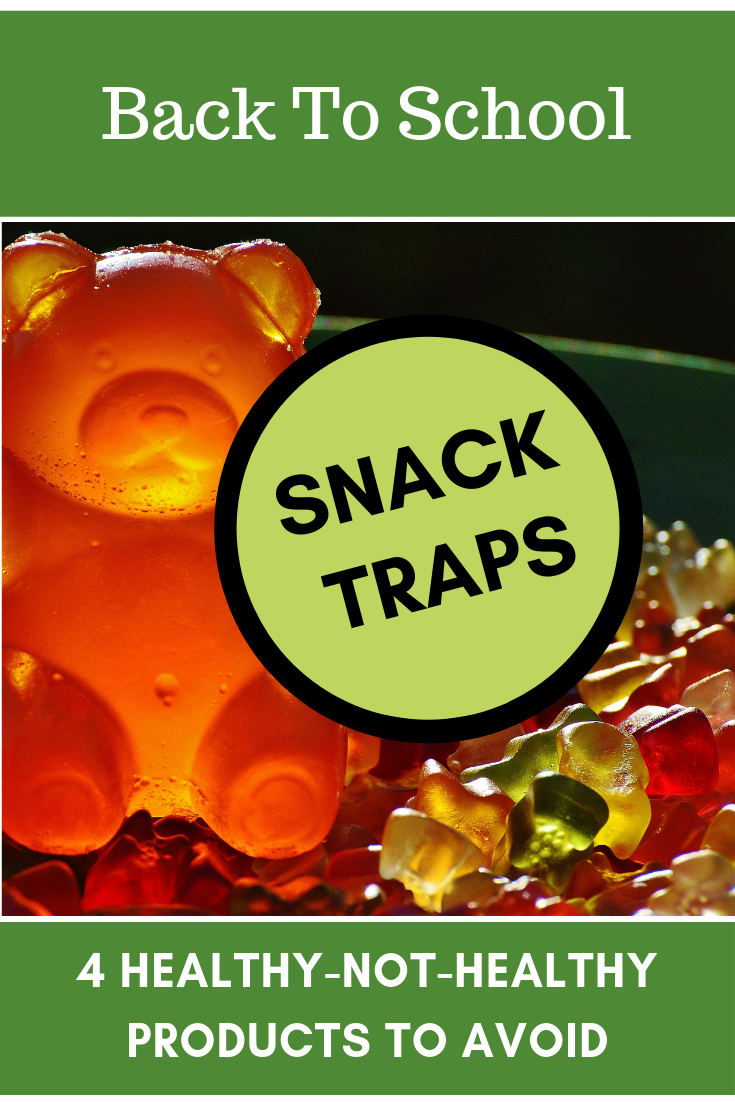
Back to School Snack Traps: Top 4 Healthy Not Healthy
And better alternatives for backpack snacks
Parents across the nation are singing the praises of the back-to-school season. Because, no matter how painful and tedious back-to-school shopping is, every parent knows that the reward for this effort is that his/her kids will be back in the classroom and out of the house soon.
If you aren’t a parent with kids in school, you may be unaware that, these days, kids are allowed – nay, encouraged – to bring snacks to school … for consumption during non-lunch times of the day. I don’t know about you, but when I was in elementary school, snacks brought from home were straight up contraband and would be confiscated without the slightest concern for low blood sugar. Now, even a few hours without a snack throws most kiddos in a kind of food-insecure mania, verging on chaos. So, we all send our kids to school with a snack or two, lest we be deemed negligent.
With Backpack Snack (BS) Season here or nearly so, let’s break down some “Healthy Not Healthy” (HNH) options that food manufacturers have been touting as nutritious alternatives to the typical Goldfish and fruit leather. Oh, and of course, all snacks must be peanut and tree nut free. So, parents, you can only pack snacks that exclude the most nutritionally dense and shelf-stable options (nuts). Just another day in the life of a 21st century parent!
I’m not trying to “pick on” or single out certain snacks as purposefully misleading or unhealthy. My aim is to compare the HNH option with the traditional or an alternative, so that we can all make informed choices.
Veggie Straws … are potato chips
This product drives me insane in its advertisement as a healthy alternative to potato chips. Newsflash: Veggie Straws are potato chips! Look at the ingredient list: potatoes, vegetable extract (for coloring purposes), salt, sugar, and oil.
Yes, it’s true that these have 30% less fat than regular potato chips. Is that a good or bad thing? If I’m trying to keep my hyperactive kid’s belly full from lunch until dinner, I want more (healthy) fat in his snacks.
Yes, it’s true that Veggie Straws are gluten-free. So are potato chips, tortilla chips, popcorn … many salty snacks are naturally gluten free.
My advice is to skip these overpriced potato chips and either just buy potato chips, or, the real healthy option is to pack actual vegetables in your kid’s backpack. Carrots, celery sticks, snap peas, and cucumber rounds all travel well. Throw in a snack-sized hummus or guacamole, and it’s a way better option than fried potatoes.
Earth’s Best Snack Bars … are low-fat cookies
Lord knows I’ve given my kids cookies as snacks a time or two – there is no shame in an occasional bribe, er, “treat”. However, when someone tries to sell me a high-priced cookie dressed up as a healthy, organic snack for my kids – oh, heck no! To be clear, organic does not mean healthy. The first two ingredients on these “Earth’s Best” snack bars are flour and sugar, closely followed by sunflower/canola oil – the same major ingredients – flour, sugar, fat – in cookies. I feel like “Earth’s Best” is a complete misnomer here.
If you are planning to give your kids organic cookies as snacks every day, these are great options; however, if you buy these in hopes of providing lots of whole-grain goodness – don’t be duped. There’s exactly 0 grams of fiber in each bar.
Yes, they are made with organic ingredients and fortified with vitamins and minerals.
Alternatively, how about some cheese and an apple? This combo provides double the calories (~150), fiber, fat, and protein – all of which are decidedly absent in Earth’s Best Snack Bars.
Annie’s (or any) Fruit Snacks are basically gummy bears
Gummies are all made from basically the same things: sugar, thickener, color, and some oil/wax to keep them from sticking together. So, when you buy “organic fruit snacks”, you are getting these ingredients – not whole fruit nature’s goodness. The major differences between Annie’s (or any “fruit snacks”) and gummy bears are these:
- Fruit snacks may not contain gelatin, which most gummy bears do. Vegans don’t eat gelatin, as it may come from an animal source. However, gelatin also provides a few grams of protein per serving of gummy bears, which is the only nutritionally redeemable characteristic of either fruit snacks or gummy bears.
- Fruit snack sugar is not corn-based. Gummy bears use cheap sugar – corn syrup. Fruit snacks tend to use more expensive (perhaps less refined) cane and/or tapioca sugar, or just anything that allows them to label as “no high-fructose corn syrup”.
- Gummy bears are colored with food dyes, whereas organic fruit snacks tend to be colored using concentrated fruit/vegetable extracts. The research on health impacts of food dye is out of the scope of this post, so we’ll just leave it as “it’s controversial”.
OK, so we have sugar, thickener, color, and wax/oil in both organic fruit snacks and gummy bears. Organic candy is still candy. They are delicious – I cannot deny that – but they are not nutritious.
Instead of candy, how about actual fruit? Not all fruit travels well, but dried fruit (apples, apricots, dates) and freeze-dried fruit (berries, lots of other options) are fairly indestructible and at least still resemble a fresh piece of food.
Fruit juice is sugar water
If you read my post on 5 Foods to Avoid for Better Health, you already know how I feel about fruit juice. In summary, fruit juice – even 100% fruit juice – is stripped of key nutritional components of whole fruit (namely fiber, which slows digestion and uptake of sugar into the bloodstream), leaving only sugar. This article in Time magazine is a great overview on “The Case Against Juice”.
Yes, juice boxes are convenient and some juice is even organic (remember, “organic” does not always mean “healthy”).
Alternatives to sugar water, er, juice are actual water (bonuses – it’s free, no-waste if put in reusable bottle), sparkling water, actual fruit.
I understand there are circumstances in which you are socially obligated to provide drinks for many kids (eg, soccer game). In this case, may I suggest Honest Kids juice drink. It is basically diluted fruit juice, with about half of the usual fruit sugar than regular juices. Plus, Honest Tea is a responsible brand and you can buy a boatload of it all at once at Costco.
There are many more examples of “healthy not healthy” snacks advertised to kids and their parents. These are the top four in my mind right now – I even just read another mom’s glowing review of most of these snacks, specifically touted as healthy choices. I acknowledge that they might be slightly healthier, than for example, a donut. However, I feel that the manufacturers of these products are a touch misleading to parents who just want to give their kids nutritious snacks.
Rule of thumb: If it is a whole food (eg, apple, egg) or has a few ingredients that you recognize as food (eg, cheese, hummus, even corn or potato chips), it’s more likely to be a good choice.
Second rule of thumb: Don’t feel guilty about feeding your kids less-than-healthy snacks sometimes. We all go on road trips, attend birthday parties, etc., where the food options are not within our control. It’s OK. Don’t stress. Emphasize and provide nutritious options, and the kids will develop healthy eating habits.
I’d love to hear what you think about kids’ snacks! Do you feel like finding healthy options is difficult? Do you think snack food labeling is misleading to kids or parents? What are your favorite go-to backpack snacks?



2 Comments
Janet
What about apple juice that says “no sugar added”?
Brook Hagen
Thanks for the question! Apple juice with “no added sugar” is 100% apple juice, and all of the calories in apple juice are from the sugar found in apples. Eating an actual apple provides fiber and other nutrients that are filtered out in the process of making juice.
Also, a typical apple has about 80 calories, while an 8-oz glass of apple juice with 120 calories. A person can drink a glass of juice in a few seconds and still want more. It takes longer to eat a whole apple, and people tend to feel more satisfied after eating a piece of fruit.
There’s nothing wrong with having a glass of juice – it’s delicious! If you’re concerned about eating too much sugar, though, consider limiting juice to one glass per day, or diluting it, or replacing it.
Hope that helps!